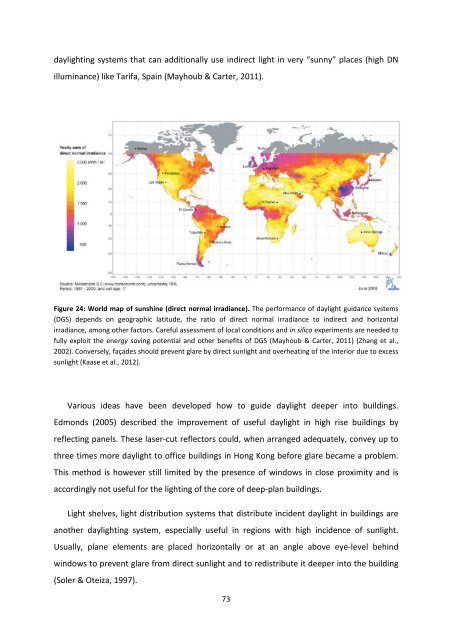MASTER THESIS Biomimetic potential of sponge ... - IAP/TU Wien
MASTER THESIS Biomimetic potential of sponge ... - IAP/TU Wien
MASTER THESIS Biomimetic potential of sponge ... - IAP/TU Wien
You also want an ePaper? Increase the reach of your titles
YUMPU automatically turns print PDFs into web optimized ePapers that Google loves.
daylighting systems that can additionally use indirect light in very “sunny” places (high DN<br />
illuminance) like Tarifa, Spain (Mayhoub & Carter, 2011).<br />
Figure 24: World map <strong>of</strong> sunshine (direct normal irradiance). The performance <strong>of</strong> daylight guidance systems<br />
(DGS) depends on geographic latitude, the ratio <strong>of</strong> direct normal irradiance to indirect and horizontal<br />
irradiance, among other factors. Careful assessment <strong>of</strong> local conditions and in silico experiments are needed to<br />
fully exploit the energy saving <strong>potential</strong> and other benefits <strong>of</strong> DGS (Mayhoub & Carter, 2011) (Zhang et al.,<br />
2002). Conversely, façades should prevent glare by direct sunlight and overheating <strong>of</strong> the interior due to excess<br />
sunlight (Kaase et al., 2012).<br />
Various ideas have been developed how to guide daylight deeper into buildings.<br />
Edmonds (2005) described the improvement <strong>of</strong> useful daylight in high rise buildings by<br />
reflecting panels. These laser-cut reflectors could, when arranged adequately, convey up to<br />
three times more daylight to <strong>of</strong>fice buildings in Hong Kong before glare became a problem.<br />
This method is however still limited by the presence <strong>of</strong> windows in close proximity and is<br />
accordingly not useful for the lighting <strong>of</strong> the core <strong>of</strong> deep-plan buildings.<br />
Light shelves, light distribution systems that distribute incident daylight in buildings are<br />
another daylighting system, especially useful in regions with high incidence <strong>of</strong> sunlight.<br />
Usually, plane elements are placed horizontally or at an angle above eye-level behind<br />
windows to prevent glare from direct sunlight and to redistribute it deeper into the building<br />
(Soler & Oteiza, 1997).<br />
73

















